Abstract
This dissertation presents the technique to be used in the development of a mobile application that will be used to effectively diagnose breast cancer by means of the popular prognostic index referred to as the Nottingham Prognostic Index (NPI).It further discussed into great depths the impact and application of mobile computing in the field of health care as well as the definite steps to be included in order to design the NPI based prognostic software. The software is to be designed by means of well documented and flexible software life cycle so that its accuracy is determined as it can be considered a mission-critical aspect of breast cancer prognosis. The predictability and repetitiveness of the software’s outcome is also determined. The system must be designed to run smoothly as an iphone application. This of course will therefore mean that the platform must be able to support it with minimal resources being devoted to the process.
Introduction
The field of healthcare provision has been redefined by means of various inventions that are targeted towards the improvement of rate of service delivery. There is however literature to suggest that the healthcare industry has not been able to effectively keep abreast with the current and rapid changes in the field of both information systems as well as information technology that have marked other industries across the globe (Chan, 2000).
There is however an increase in the rate at which technological advancements in the field of information technology and Information systems is being implemented in the healthcare domain. It is therefore crucial to denote that the current mobile applications that are in the healthcare systems can best be described as being both in the emergent stage which is in fact enabling to the entire system processes (Ammenwerth et al, 2003).
Problem statement
There are many things that contribute causally to the quality or characteristic that gains a favorable reception or acceptance in the treatment of breast cancer which prognosis is one of such. With the implementation of a hand held device like iPhone, the patients will be able to send messages across to the medical practitioner for correction in relation to health matters.
However, There is believe that the use of iPhone technology in healthcare will enhance owing to its possibility in supporting health functions, e.g. to document and converse the patient health record by electronic means, and to use health check orientations when needed. Thus, it appears accepted to use iPhones and other technology support for health purposes. However, the result of the healthcare outlook will be contingent upon the utilization of technology. Both the patients and healthcare practitioners must not only be aware of the enhanced and sophisticated technology, but obligated to be educated in its application and promise.
Aim and objectives
Aim
The aim of the paper is to come up with prototype software to be used in the process of aiding breast cancer patients in the calculation of NPI score that is necessary for the tracking of their prognosis. The software is to be designed so that it can save the data in a database that is accessible to the patient’s doctors. On the other hand, the data will be sent to the doctor via e-mail where he will retrieve and record the patient’s data from the email.
Objectives
The objectives of this paper are geared towards the development of an NPI dependent software application that can effectively run on iPhones. The objectives that should be achieved are expressed by three definite goals. These are:
- Design the application that will calculate the NPI and show the prognoses score.
- Draw a graph of the possible survive in 5 years.
- Save the patients information into a local database to allow the patient to view their history scores and update it with their doctor.
Motivation
The prediction of the survival rate of patients with cancer without the need of any form of medication is referred to as prognostication and has for a long time been a very complicated task to achieve (Haibe-Kains et al,2008). This is further complicated by the fact that the breast tumors are usually heterogeneous in terms of their molecular structures and therefore are prone to the exhibition of varied clinical outcomes. The prognostication process has however been simplified in the recent years by the application of complex and usually accurate Information Technology (IT) techniques.
The advantages associated with the use of mobile technology in the health care sector are numerous. They include;
- Improved care to the patient
- Increased quality of health care services
- Reduction in the number of clinical errors
- They result to a general increase in the rate of resource integration
- They can effectively allow for a ubiquitous access to the required patient information in real time and the provision of updated medical information of the patient (Bang et al,2005)
The software is to be developed on the basis of the histological grading of cancer which is a method that is widely accepted in the medical circles (Stierer et al,1991).There is however a looming criticism of the methods that is attributed to their subjectivity. According to Elston and Ellis (1991).The Nottingham Prognostic Index (NPI) is developed as a modification to an earlier technique referred to as the Bloom-Richardson grading. The Bloom-Richardson grading was postulated by (Bloom and Richardson, 1957) and is documented to possess remarkable prognostic efficiency. The main criteria of adopting the Nottingham Prognostic Index (NPI) are its ability to effectively produce the right prognostic information with better rates of reproducibility of the required histological grading. The reproducibility of this system was extensively documented by Robbins et al, (1995).
The Nottingham Prognostic Index (NPI) has the advantage of effectively providing a prognosis for breast cancer patients who are in need of adjuvant treatment and is reliant on three prognostic indicators. The following is the equation used to evaluate the Nottingham Prognostic Index (NPI)
NPI = [0.2 X tumor size in cm] + tumor grade [1-3] + lymph node stage [1-3]
The prognosis is then presented or rather derived according to the grading table below:
This has been shown to give the following prognoses:
Source: Galea et al (1992).
It is worth pointing out that the last couple of years have seen several advancements in terms of the methods that are dedicated to the prognostication of breast cancer. This has essentially been realized by a variety of pathological indicators which consist of the histological placing, size of the tumor and the participation of the lymph lumps in the life of a Breast Cancer patient. The criteria used are as complex and often are formulated as an index. For patient who should receive adjuvant therapy the St Gallen consensus criteria can effectively be used in the process of coming up with their prognostication (Goldhirsh et al.,2003),The other guidelines are the NIH guidelines as postulated by (Eifel et al.,2001).
Time frame
Orgnisation of the dissertation
Chapter 1 of this dissertation discussed the aim and objective of the paper in relation to the prototype software by the aid of an iPhone to be used in calculating the NPI prognosis of a breast cancer patient. It further explained the motivation of the device in conjunction with the Nottingham prognostic index (NPI).
Chapter 2 of this dissertation presents a general view on the subject of mobile computing in the health care industry by focusing on the existing models. it further discussed the challenges of the hand held device.
Chapter 3 of the paper talked about the iPhone software’s operating systems (iOS) development, the iOS Architecture, Layers of iOS, Choice of Language, software requirement and hardware requirements.
Chapter 4 expatiated more on the uses and effectuation of the iPhone in conjunction with the NPI. It also discussed the Program design algorithm, Requirement and analysis, System Architecture, database architecture and lastly the deployment of the application.
Chapter 5 explains the summary of achievement in lieu of the NPI application with the IOS programming and the limitations and future enhancement of the application.
Chapter 2
Introduction
This chapter presents a general view on the subject of mobile computing in the health care industry. Our focus is therefore placed on the existing models. Arshad, Mascolo and Mellor (2003), describe into great detail the methods and techniques of exploiting the various mobile computing technologies in the larger healthcare sector.
History of iPhone application technology
The iPhone Software Development Kit was introduced in 2008 by Apple. Both iPhone and iPod touch suddenly became the handheld computers they were meant to be.These are mobile computer but not simmilar as a mobile desktop. it’s hardware and software make it possible to wander the world, or even the neighborhood, hence keeping one connected to whoever , whenever and whatever one wants to do. it enables a here and now applications that gives access to content-rich services and gives information about whats going on in the sorounding thus enabling interaction with services or others on the internet. (Goldstein and Bove 2010).
Overview about the available personal health care
iPhone devices have progressed remarkably from mere voice communication machines to state of the art platforms that can send and receive e-mails, take mega-pixel digital pictures, access websites, and even monitor biometric information. It is expected that these platforms and their future versions will steadily gain momentum and support from a worldwide ecosystem of application developers, device vendors and wireless network operators.
In healthcare the use of Iphone involves conducting healthcare related activities. However, probability and accessibility of this device enhances the use in healthcare environment. Moreover, ease of use, affordability, and ability to read handwriting attracted use of this device (A-Ubaydli, 2004). The device is suitable for conducting patient’s healthcare activities in emergencies, ward rounds, homecare, cancer disease management, conducting clinical trials and so on. iPhone is suitable for healthcare as practitioners are mobile and they would like to enter information in patients record and process information about the patient (Reuss, Menozzi, Buchi, Koller, & Krueger, 2004). Patients health information will be available at the time of query due to this device and their won’t be interruption with the workflow (Eisenstadt et al., 1998). Moreover, this device can assist in ensuring patients safety by providing easy availability of the data at the point of care, since most health care institutions now has computerized order system for medical errors (Ash, Stavri, & Kuperman, 2003). Mobility of this device embraces usage of computerized physician entry systems (Schuerenberg, 2005) and enhances patient’s safety.
A study conducted by Fischer, Stewart, Mehta, Wax, and Lapinsky (2003) indicates that this device is used to access medical literature, as drug information data bases, patients tracking, medical education, pain management, critical care, cardiology and cancer (Fischer et al., 2003).
challenges in the adopted NPI application technology
Companies have been forced to improve the way they take on form or shape and introduce products to the market by the aggressive forces, cost challenges, and increased customer. New product introduction can help in refining internally born ideas, or trying to respond to customer requirements and market demands, the new product introduction process can help. It facilitates all components to speak a common language. It automates tasks, exposes performance bottlenecks, drives consistent execution and continuous improvement. And, it provides management visibility into the product development pipeline. Since NPI is so intertwined with other product development processes, its adoption and execution significantly influences your potential for success.
An effectively deployed and adopted new product introduction process enables you to properly manage product development activities in order to deliver the right products to the market at the right time, while keeping costs under control. Some of the many benefits resulting from optimizing the new product introduction process include one of the hallmarks of a great iPhone application is that it leverages the iPhone SDK includes tools such as MapKit, which makes it much easier to use the location-based features of the iPhone in an application.
They point out clearly that mobile networks are usually divided into two categories. The ad-hoc and nomadic networks. The ad-hoc network is characterized by the inclusion of two mobile devices in enabled states. These devices are able to communicate with each other in compatible network architecture. The disadvantage of this model is that it best for a peer-to-peer communication and the availability. This therefore means that there is never a guarantee for the services as well as the resources. This is obviously not the network architecture on which the NPI software application is to run on as the NPI software application can be considered to be a mission-critical application. The second mobile network which is referred to as nomadic network is the one to be used for the NPI. This is because it the best suited to support resources that rely on fixed architecture.

As an illustration it is worth noting that several mobile based healthcare platforms that of course are dependent on wireless communication and GPS have effectively been deployed in various countries such as in Sweden for ambulance services (Geier, 2006) and in the Netherlands in the provision of emergency health services to victims of trauma. The mobile health care platforms must be able to collect all the vital data that is necessary not be used in the derivation of the appropriate diagnostic arguments. The system to be developed is to be efficient as the one that was deployed in Finland.
The characteristics of the mobile platform are to be able to provide the required diagnosis to only the authorized individuals within the shortest of time. The system must be able to allow the health care practitioners to feed the necessary data in order to retrieve the information they need on the patient’s prognosis from any given location. They should also be able to get the information while undertaking their day to day ward rounds
Challenges
There application of mobile computing in the form of handhelds in the field of healthcare has rapidly gained momentum in the last couple of years (Baumgart,2005).The main motivation behind the adoption is the provision of the very highly important information required for efficient prognosis and treatment of the patient at hand. There are various challenges that face the adoption of these forms of technology.
Extant literature has been dedicated the study of the most common challenges that face the adoption of mobile computing in the healthcare sector.
A study by Lu et al (2006) identified two major barriers in the adoption of the technology to the healthcare industry. Their first barrier is attributed to the design of the devices themselves. This is to mean the physical design of the devices itself. The second one is inherent lack of proper support from the organizations that provide health care services. They noted that these can only be tackled effectively by the designers and manufacturers of the systems as well as the various health care facilitators. The knowledge of these challenges is crucial in order to come up with an improved system that is intended to provide cancer patients with accurate prognosis for the benefits of increasing their longevity through the making of accurate decision based on the predictable aspects of the computer based NPI hardware and software.
Chapter 3
Introduction
Overview about the content of this chapter
The iPhone, iPod touch, and iPad device are run by an operating system known as iOS. The device hardware is managed by this operating system as it provides the basic machineries needed to put into practice indigenous appliances on the phone. The operating system also dispatches with several system appliances, such as Phone, Mail, and Safari that provide customary system services for the user depending on the device.
Tools and interfaces required to develop, establish and run custom native applications is contained in the iPhone SDK. The iOS system frameworks and the Objective-C language that run directly on iOS. Native applications are built. Installation of native applications is done physically on a device and can run with or without the presence of a network. They reside next to other system applications and both the application and any user data is synced to the user’s computer through iTunes.
The project is developed using the methodology of object oriented design. The merits of this methodology are various. We however adopt the foundation model of development for this project. Various classes must be defined in the development of the application. It is also necessary to ensure that there is utmost emphasis on the associations between the classes and their related objects. All attributes and services must be fully used and there should be optimization in terms of the selection of objects. A clear definition of all the attributes semantics is therefore necessary.
overview of IOS Development
The Iphone, iPad and iPod touch are run by the iOS which is an operating system.
The device hardware is run by the operating system. The operating system also supplies the fundamental technologies considered necessary for the executing the phones indigenous applications. The operating system also dispatches in the midst of some system applications which present typical system overhauls for the user. However this depends on the system.
The iPhone SDK includes the instruments as well as computer circuit consisting of the hardware and associated circuitry that links one device with another for development, installation and running of the typical custom. Typical applications are made by combining materials and parts using the iOS system structures and the Objective-C language and they function without deviation on iOS. Distinct to web applications, native applications are physically mounted on a device and can function independently either or not a network connection is present. They exist subsequently to supplementary system applications. The application together with whichever user data operates in unison to the user’s computer via the iTunes.
The iOS Architecture
The iOS architecture has the same or nearly the same characteristics with the essential architecture instituted in Mac OS X. At the elevated intensity, iOS operates as a mediator linking the fundamental hardware with the applications that emerges on the monitor, as revealed in Figure 1-1. Applications that are produced on no description interrelate unswervingly amid the hardware however as an alternative go via system interfaces, which act together among the suitable drivers. This concept guards the application from modifying to the fundamental hardware.
When the application is in general sheltered from alters to the underlying hardware, there is need to explain for various dissimilarity between devices in the system. For instance, iPhones is capable of opening URLs while an iPad or iPod cant.
The execution of iOS technologies is sighted as layers, which are shown in “Game Kit Framework.” At the subordinate layers of the system are the basic utility on which all applications bank on, while higher-level layers include supplementary advanced overhauls and technologies.
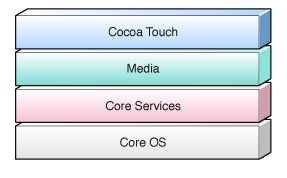
Higher-level frameworks should be used instead of lower-level frameworks when writing the code. This is so because the higher-level frameworks offer purpose oriented thoughts for lower-level constructs.
The purpose oriented thoughts reduces the number of lines of code one has to write and encapsulate potentially complex features like sockets and threads hence making it trouble-free to write them. However, in as much as they conceptualize the lower-level technologies, they do not facade the technologies. For developers who wish to use them or want to use features the frameworks that are not exposed at the higher level can use them since lower-level frameworks are still available.
Choice of Language
In deciding on the program language to be used to build the language of this application, the objective-C is chosen. Objective-C applications are capable of using every features provided by the Mac OS X operating system. However Cocoa includes an extremely flexible, extensible, and dynamic set of classes that can only be created with a flexible and dynamic language like objective-C (Anguish, Buck, and Yacktman 2003).
Apple’s engineers noted that Cocoa could not have been written with a less dynamic language. The dynamism and flexibility of Objective-C contribute to the high degree of code reuse and productivity that Cocoa programmers enjoy. Moreover, Objective-C is an extension of the C language.
Parts of the C language are used less often in Objective-C. On top of the C language, Objective-C adds a few new types, several keywords, and some new idioms. It is designed to be simple yet powerful. Because of this, it is easy to learn the key points in just a few minutes. In addition to this the principal new idiom that Objective-C adds to C is the concept of messaging between objects. Objective-C includes the language elements needed to declare objects, specify the messages that the objects understand, and send messages to objects.
Although, messaging is the reason that Objective-C is so dynamic. A message is a request for an object to do something. In Objective-C, the syntax for sending a message is as stated below:
[someObject doSomething]
The square brackets ([and]) indicates the start and end of a message block. The variable someobjects is the receiver of the message. The variable doSomething is called a selector and specifies the message to send. Furthermore, messaging always takes the following form:
[receiver selector]
However, messages can include arbitrary arguments and can return values. Any message can be sent to whichever receiver. If the receiver does not understand a message that is sent to it, a runtime error occurs. However, errors are easily avoided because at runtime it is possible to determine whether a particular receiver can understand a particular message before the message is sent.
Software Requirements
The iPhone SDK comes with all of the interfaces, tools, and resources needed to develop iOS applications from your Intel-based Macintosh computer.
Apple distributes nearly all of its system interfaces in an extraordinary package known as the frameworks. A framework is a listing of the files stored in memory that includes a vibrant distributed library and the source of aid or support that may be drawn upon when needed to sustain the library. In the usage of frameworks, it is linked to the application project. Linking it to the project gives right to use the attributes of the framework and allows the development instruments know where to locate the heading records inclusive of the framework resources.
In addition to frameworks, Apple furthermore distributes various technologies in the shape of normal shared libraries. Since iOS is supported by UNIX, several technologies that structure the operating system lower-levels are obtained from open-source technologies. The (computing) a program that controls a display for the user (usually on a computer monitor) and that allows the user to interact with the system for these technologies are consequently obtainable in the interface directories and standard library.
The other vital constituents of the SDK include:
Xcode Tools: the IOS application development is presented by the Xcode tools as well as the vital functions stated below:
- Xcode – incorporated advanced environments that run the functional projects by correcting, assembling, running, and debugging the code. The Xcode incorporates with several additional tools. However, it is the major application used for development.

- Interface Builder – this is the tool used for bringing together the user interface with respect to vision. The interface objects produced are banked in a unique file layout and packed into the application at the time at which a (software or multimedia) program is run.
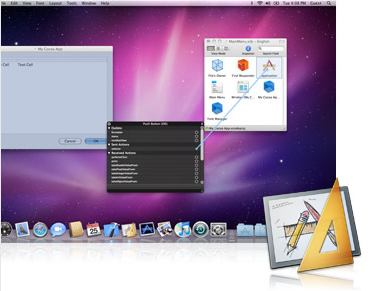
- Instruments – this is a runtime presentation assessment and debugging tool. It can be used to collect data about the application’s runtime performance and recognizes prospective difficulty.
- iPhone Simulator – Mac OS X application reproduces the iOS technology load, permitting the test of an iOS applications on the computer which is macintosh Intel–based.

- OS Reference Library– the SDK comprises of the a remark that calls attention to certification for iOS by an option that is selected automatically unless an alternative is specified. Information to the library are also transfered automatically when they are accessible. However, the SDK supplies the software require for developing the applications.
Hardware Requirements
In order to build this application, it is necessary to supply these hardware devices. The system needs a Mac OS X computer operating with the Xcode tools to assemble the application when the application is built on the computer.
Chapter 4
Implementation
This chapter describes the basic application and installation of the iPhone software and uses of the iPhone in calculating and filling the daily NPI of a patient. It further explains how a user will be able to calculate the NPI of past and current dates, and viewing the history of the previous data in the device. It further gives details on how the NPI history can be forwarded to the doctor by email for diagnosis and the grading of the NPI value. The chapter also describes the iPhone program algorithm thereby stating the development lifecycle of the device hence analyzing the functional requirement of the device and the system architecture and the designing of the iPhone device where the coding, the testing, and deploying stage were being explained. In line with this the installation of the application will guide the user in a step to step user friendly guide on the processes undertaken in the designing and installation of the iPhone on a device.
Software Description
Getting started with the system
The Application should have deployed on the device where it needs to be run. When user installs the application on the device, the LOGO icon for the application will appear on the device and while being clicked it will start the application.
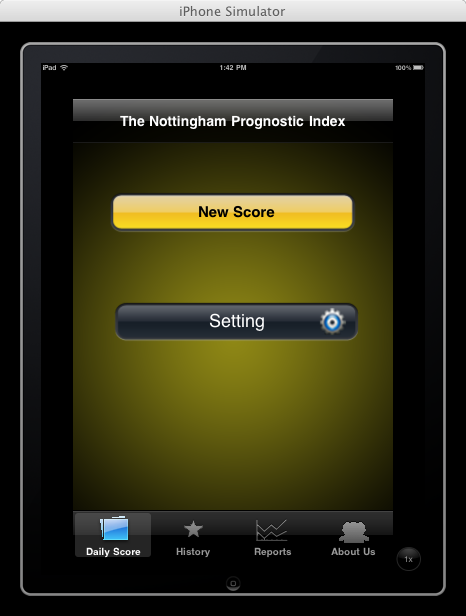
The startup screen/Splash Screen will contain the name of the application and will appear on the screen for 2-3 seconds, after that the above screen will appear.
Saving the User’s personal Information
As the user will start the application he/she needs to save his/her personal information first before going further. So there is a button available on the main page namely “Setting” and when user clicks on that button it will open the setting window which will have the required field to be filled by the user. After filling the information he/she will press the “Save” button to save the data in to the database.
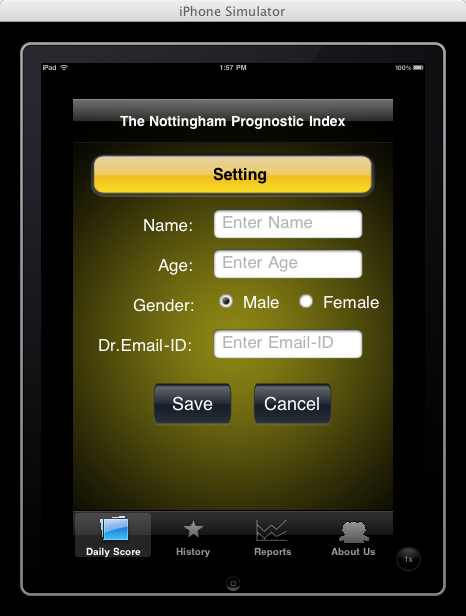
There will be a “Cancel” button available on the same page to cancel the process.
Calculating the NPI
Once the user is done with filling the information on the setting page, he/she can calculate his/her NPI by going to the “Score page”. In order to get there on the “Score page” he/she will have to click on the “New Score” button on the “Main Page”, when user clicks on the “New Score” button it will redirect the user to this page.
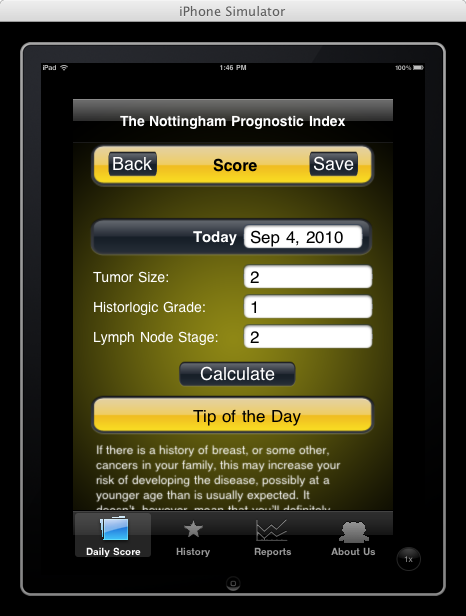
This page contains three input box meant for taking the data from the user, user will have to fill the correct data in right format by selecting the picker and using the keyboard in order to get the NPI calculated, user are advised to enter the correct format of data.
Viewing the Current NPI
Once the user is done with filling the data in the available three input box, he/she will have to tap on the calculate button in order to see the result, and when a user taps on the calculated button it will bring a pop up which contains the calculated NPI and the relative grade.
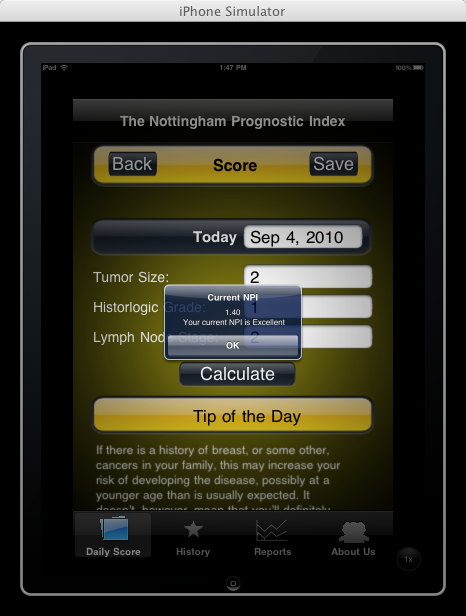
Viewing the Tip of the Day
Each time when user will back to the New Score page, the “Tip of the Day” section will show the random tips.
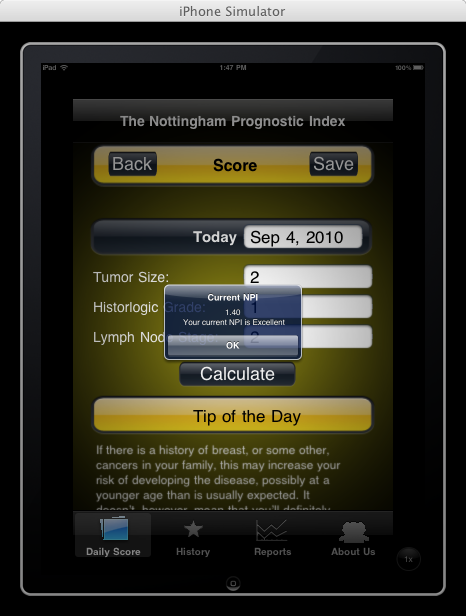
Calculating the NPI for any Past date
If a user forgot to enter/calculate the NPI for any previous date for any reason, and he/she wants to add the data for the same, he/she will able to do this by selecting the respective date from the date picker that will appear on the screen when user will taps on the today label/text box and after selecting the date he/she can enter and save the data for any date in same way.
Viewing the History
If a user using the application on the daily basis the application will save his/her daily record in the database and if a user wants to see the previous data, he/she will have to tap on the “History” tab on the bottom tab bar.
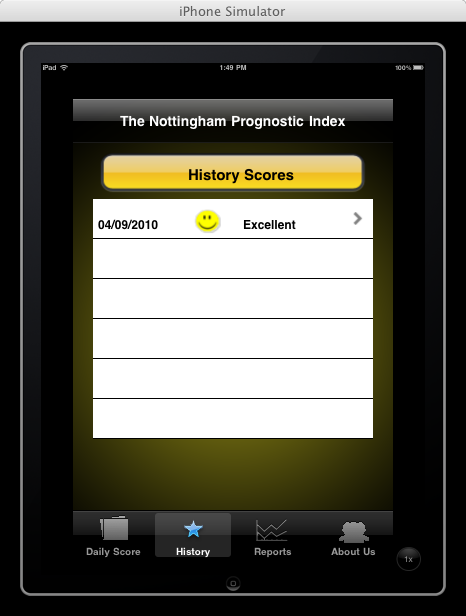
When user taps on the History tab, it will bring the user to history page, which contains the date wise data and the respective grade with respective smiley. Happy smiley meant for good and excellent results and sad smiley is meant for Poor and Moderate results.
Viewing the Report for any specific day
As the history page contains the list of dates, and if a user wants to see the full report of that date, he/she will have to tap on that particular row. When he/she will tap the row it will bring the user to report page which contains the each and every details of that particular date including the graph.
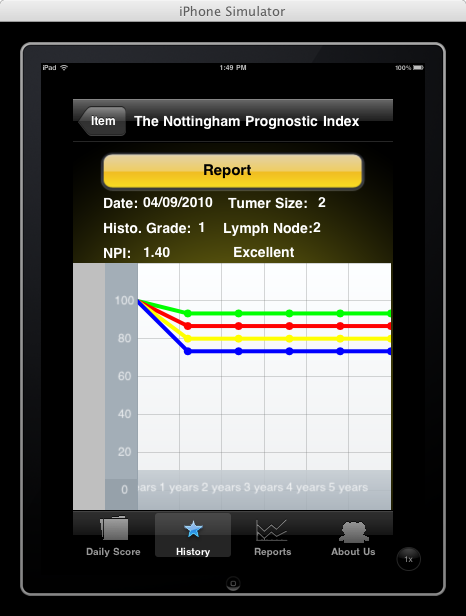
Sending the report in email to doctor
If a user wants to send his/her report to doctor to analysis he/she will have to be on the report page, there is a “Email report to doctor” button/icon available, he/she will have to tap on this, a new window will appear with the details report and the Dr’s Email Id in the “To” filed, user will then put the subject and message and tap on the send button in order to send the mail.
Seeing the Report
If a user wants to directly see the current last updated report/graph, he/she will have to tap on the “Reports” tab on the bottom tab. When user will tap on this tab, it will redirect the user to the report page which contains the graph.
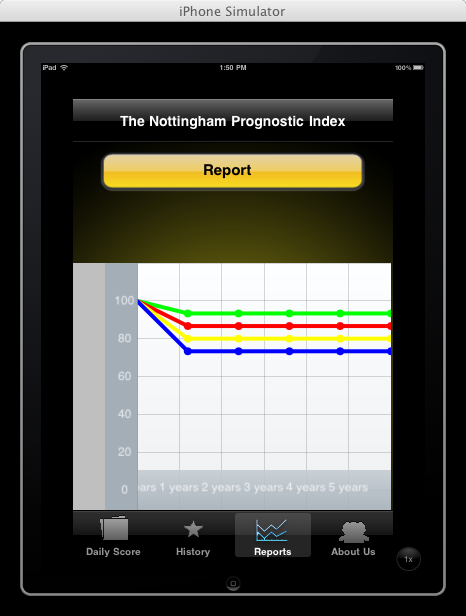
Sending Email to Technician
If a user wants to send a email to the technician, it will be done by going to the about us page, there is a “Email” button/icon available there and while being tapped will bring a new email window with predefined email id user will fill the subject line and will press send button in order to send the email. Cancel button while being tapped by the user will disappear the email window and bring back the user to about us page.

Viewing Grade chart
If user is aware of the grade (Excellent, good, Moderate and poor), and wanted to know about the grading and relative NPI value. He/she will have to go to the about us page. He/she can tap on the “About Us” button to get on to this page. Once user will be on this page the grading table will be seen to him/her.
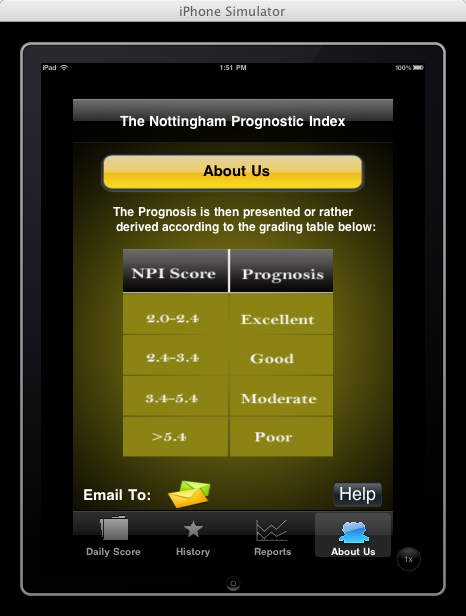
Taking help about the application
If a user is new to the apps and does not know about the system, and wish to see help, he/she will have to tap on the “Help” button available on the about us page. When “Help” button will be pressed/taped it will bring the help window which contains the instructions to how to use the application.
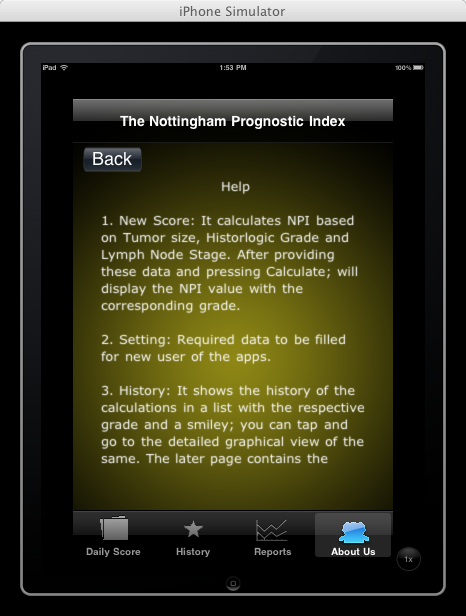
Images of iPhone cited in google iphone images.
Exit the Application
Just by pressing start button on the device will exit the application.
Program design algorithm
Design
An IPhone mobile application without variation or change comprises of an exclusive quality in terms of functionality and characteristics. Identical to all software application, an iPhone application experiences a development lifecycle. The iPhone mobile application development lifecycle possess the region of code in which an identifier is accessible and the quality of being intricate and compounded. It has to go through a series of logical stages during its development cycle. The similar things placed in order of phases include an “outset phase, the planning phase, the execution and the distribution phase”.
Each phase assists the development team to institute goals, setting up any inaccuracy and completing the development procedure effectively. Read more: http://www.articlesbase.com/programming-articles/the-fourdevelopment-phase-for-iphone-application-development-831665.html#ixzz0ysZI9QoD. Under Creative Commons License: Attribution
These steps are outlined as follow:
Requirement and analysis
In systems engineering, a requirement can be an explanation of what a system must do, referred to as a Functional Requirement. In our application it is as follow:
High Level Functional Requirement for NPI Apps
Following mentioned are the high level requirements for the application.
- Tumor Size (User Input)
- Histological Grade (User Input)
- Lymph node Stage (User Input)
-
- Calculate NPI
- Show NPI
- Save NPI
- Save Tumor Size to Database
- Save Histological Grade to Database
- Save Lymph Node Stage to Database
- Show Tips of the Day
- Create History for the NPI
- Maintain History
- Show History
- Create Report
- Create Graph
- Email Report to Doctor
- View About us.
System Architecture
Based on the Requirement which have been filtered while analysis of the system, following are the two designs explaining the system and requirement of the system as well as the user interaction.
- UML Use Case Diagram.
- System Flow Chart Design
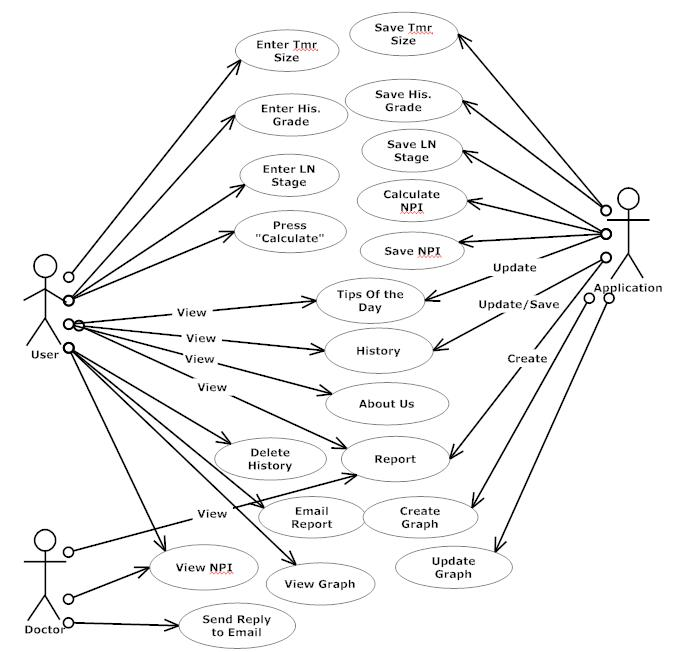

Database architecture
Based on the Requirement which have been filtered while analysis of the system, following are the diagrams that used to analysis the database requirements
- Entity relationship diagram
- Data model for NPI application
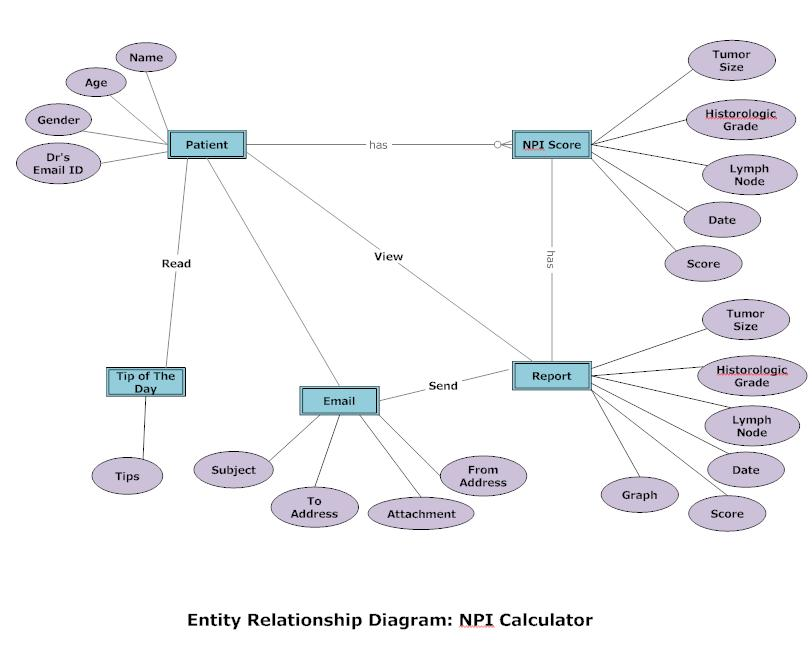

Data Modal for NPI
Design
There is a unique challenge in designing a handheld device. The Limited in size of the screen entails the designer to recognize the vital features of an application. However, lesser features must be incorporated in contrast to a comparable desktop application. In the iPhone design little text entry should be incorporated because of the absence of physical keyboard. The crop-up keyboard that is on the screen is useful but not to be banked on for broad text entry. Contrast to the standard desktop application, It is necessary to redesign the iPhone because scroll bars and drop down menus are not incorporated.
The iPhone innovated a multi-touch screen that does not have a physical keyboard and a measuring device. Recognizable desktop operations are substituted with touch screen. In iPhone touches senses easy signals such as choice and dragging in addition to multifaceted signs such as “swipes, pinch-in and pinch-out”.
The built-in measuring device senses the movement of the device and familiarization.
Face-up, face down, landscape right landscape left, and representation are the incorporated positions. A standard control user interface design toolkit is incorporated with iPhone. In addition there are windows and task handling keys.
Code
In the coding stage, the xcode Platform SDK 3.0 is used as a platform to write the java coding. This platform supports the necessary libraries which are required to build mobile applications.
Test
Before installing the application on the device, it should be tested by using a base common simulator device to mimic the functionality present in actual devices that the NPI application is targeting. This simulator is a part of the iPhone SDK which provides this functionality and imitates it on a computer device.
Deploy
This is the final stage which is installing the application on the iPhone, or iPod Touch device. In order to check the iPhone applications on the device, the iPhone Development Certificate from the iPhone Developer Program Portal is necessary.
After that the user could connect his iphone or iTouch to the computer via usb cable and pree run then it will be installed directly into the device.
Chapter 5
Introduction
A summary of the purpose of this research and certain aspects involved in the process have been done in this chapter. It also discusses the limitations of the work. Objectivity is maintained throughout the discussion to provide a meaningful interoperability of the work for future research.
Summary of Achievement
The novelty of this work is an anticipated outcome that is intended or that guides the planned actions on the implementation of a NPI application with IOS programming platform that prognoses breast cancer established as a centre of operations on Nottingham prognostic index. However, the fundamental assumptions from which this work was begun, developed, and explained was to direct efforts towards aiding the problem of breast cancer, such as how a patient would solve the problem of breast cancer with the aid of the iPhone device in calculating the NPI score that is necessary for the tracking of their prognosis. Consequently, the most specific issues that were concentrated on are the objective and on how to solve the problems listed below:
- Save the patients information into a local data base to allow the patient to view their records history and update it with their doctor.
- Design the application that will calculate the NPI and show the prognoses score.
- Draw a graph of the possible survives in 5 years.
Limitations/Future Enhancement of the Application
Certain limitations in the work were encountered. It was never the purpose of this study to tackle these limitations in full. The main reason was the time restriction in which the research was conducted. Another limitation that faced the study was the lack of resources and references in this field since it is quite a new research area especially the area concerning work on mobile application programming.
As the whole system is working on the local device database and having no outside web services available, so the size of the memory of the device might have some limitations, otherwise there are no limitations in the application.
Nevertheless, further research will be based on how the whole system is meant for the health of human being who is suffering and going through some specific illness. So in future if a user wants to enhance the functionalities of the apps he/she can able to make it extended in following manner.
The exercise functionality, i.e. if a user is having some NPI and for that particular NPI what cares he/she needs to take can be added.
Direct communication to the Doctor functionality can also be added in the application in future.
List of References
Al-Ubaydli, M. 2004, Handheld computers. British Medical Journal,7449(328), 1181-1184.
Ammenwerth,E, Graber,S ,Herrmann, S. 2003.Evaluation of health information systems—problems and challenges, Int. J. Med. Inf. 71 125–135.
Apple, I. 2008. “iPhone developer Center” Apple Developer Connection. Web.
Arshad, Mascolo and Mellor 2003. Exploiting Mobile Computing in Health-care. Web.
Ash, J.S., Starvri,P.J., & Kuperman, G. j., 2003. A Consensus statement on considerations for a successful handheld device implementation. Journal of American Medical Informatics Association, 3(10), 229-234.
Bang, M, Larsson, A. Berglund, E. Eriksson, H., Distributed user interfaces for clinical ubiquitous computing applications, Int. J. Med. Inform. 74 (7-8) (2005)545–551.
Barney, L., 2009. Developing Hybrid Applications for the IPhone: Using HTML, CSS, and Javascript to Build Dynamic Apps for the IPhone. Boston, MA. Addison-Wesley.
Baumgart D.C., 2005. Personal digital assistants in health care: experienced clinicians in the palm of your hand?
Bloom H.J.G. and Richardson W.1957. Histologcal grading and prognosis in breast Cancer. Br J Cancer 11: 359-377.
Bollapragada, V., White, R., and Murphy, C. 2008. Inside Cisco IOS Software Architecture. Indianapolis, IN: Cisco Press.
Chan, A.T.S. 2000. WWW+ smart card: towards a mobile healthcare management system, Int.J. Med. Inform. 57(2000) 127–137.
Eifel P, et al. 2001. National institutes of health consensus development conference statement: adjuvant therapy for breast cancer. J. Natl. Cancer Inst 93:979–989.
Eisenstadt, S.A.,Wagner,M.M.,Hogan, W.r., Pankaskie,M.C., Tsui,F.C, & Wilbright,w.1998. Mobile workers in healthcare and their information needs. Proceedings of the AMIA Symposium.
Elston C.W. and Ellis I.O. 1991. Pathological Prognostic factors in breast cancer. I. The value of histological grade in breast cancer: experience from a large study with long-term follow-up. Histopathology 19: 403-410.
Faucheur,A.L.,P.Abraham, et al. 2008. Measurement of walking Distance and speed in Patients with peripheral Arterial disease: A Novel Method Using a Global Positioning system.” Circulation 117(7): 897-904.
Fischer,S., Stewart, T. E., Mehta,S., Wax, R., & Lapinsky, S.E. 2003. Handheld computing in medicine. Journal of the American Medical Informatics Association, 2(10), 139-149.
Forjuoh, S.N., M. D. Reis, et al. 2008. “Improving cancer self-care with a PDA in ambulatory care” TELEMEDICINE JOURNAL AND E-HEALTH 14(3): 273-279.
Galea M. H, Blamey R. W, Elston C. E, Ellis IO 1992. The Nottingham Prognostic Index in primary breast cancer. Breast Cancer Research & Treatment; 22(3):207-19.
Goldhirsh A, et al. 2003. Meeting highlights: updated international expert consensus on the primary therapy of early breast cancer. J. Clin.Oncol 21:3357–3365
Goldstein, N. 2009 IPhone Application Development for Dummies. NJ. For Dummies.
Goldstein, N. and Bove T. 2010 “ IPhone Application Development All-In-One For Dummies” Indianapolis. For Dummies.
Hayat, M. A. 2008. Cancer imaging: Lung and breast carcinomas. California. Academic Press.
Haibe-Kains et al. 2008. A comparative study of survival models for breast cancer prognostication based on microarray data: does a single gene beat them all? Web.
Images of iPhone [Electronic print]. Web.
Kangasharju, J. Tarkoma S., 2009. Mobile middleware: Architecture, patterns and practice. Wiltshire, Great Britain. John Wiley and Sons.
Robbins P, Pinder S, De Klerk N, Dawkins H, Harvey J, Sterrett G, Ellis I, and Elston C. 1995. Histological grading of breast carcinomas: a study of interobserver agreement. Humt Pathol 26: 873-879.
Scott, A., Buck, E. M., Yacktman, D. A. 2003. Cocoa programming. U.S.A. Sams Publishing.
Stierer M, Rosen H and Weber R. 1991. Nuclear pleomorphism, a strong prognostic factor in axillary node-negative small invasive breast cancer. Breast Cancer Res Treat 20: 109-116.